As we build up to the 20th anniversary of Pokémon in February 2016 and look hotly ahead towards brand new things, we're continuing our journey through each generation of Pokémon, this month we cover the generation that's the most recent to be fully completed. If you need to catch up before reading ahead, be sure to check out our retrospectives on generation 1, generation 2, generation 3 and generation 4.
The build-up to launch
The build-up to this generation is somewhat different to previous ones. While the last ones all had years of hype and build-up, this one came quite suddenly. In January 2010 a note was posted on the official Japanese site saying that a new Pocket Monsters series game was coming. Nothing further was said until February when Junichi Masuda showed a special silhouette on the variety show, Pokémon Sunday, and soon after the Pokémon Zorua and Zoroark were revealed for that year's movie. After that nothing was heard of it until April when the first images of gameplay were shown: a trainer in a large 3D city, confirming as well that the games were coming to the Nintendo DS, not the then-recently announced Nintendo 3DS, marking the first time there were two generations on the same device (barring backwards compatibility in Generation 2). From there, monthly news started coming revealing a variety of Pokémon and features up until its launch in September 2010. This was the quickest public build-up to a generation that had existed.
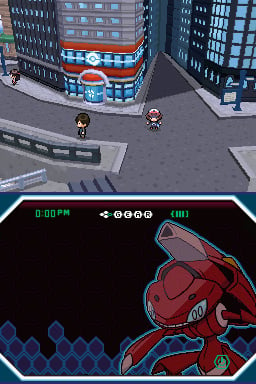
The main series
The games came out on September 18th 2010 in Japan and March 2011 in the West, and with it came a brand new era of Pokémon.
Pokémon Black & White were different from their predecessors in a specific way. Game Freak wanted the feeling to be like when players first played Pokémon Red & Blue, so it completely locked out backwards compatibility until the post-game and made it so that you would only play with and encounter brand new Pokémon until you'd completed the game. This made the entire game feel fresh and acted like a soft reboot.
In the game you play as a new trainer starting out from Nuvema Town as they travel through the Unova region, once again beating gyms. However, these games took a shift from previous entries and became far more story heavy with the story about an orphan, N, and how he feels Pokémon are being enslaved. With Team Plasma behind him he tries to free Pokémon, but not everything is as it seems.
As Black & White were on the same device as the Generation IV games, there were not that many improvements overall to the engine. While the games were more ambitious with the 3D environments, mechanically the games didn't change all that much. More moves were added for the variety of new Pokémon, many of which had unusual types, and many Pokémon were given new "Hidden" abilities, but the battle system was not changed much. That said, it did introduce two new different types of battles: Triple Battles and Rotation Battles, where you had 3 Pokémon on the field at once, making more strategy than ever before.
Despite the minimal changes the battle system, Black & White did include a lot of groundbreaking features for the Pokémon franchise. It implemented the Pokémon Global Link, which is a website that tracks GTS and Battle data, as well as having a Dream World where you could play mini-games to get Pokémon with their Hidden Abilities. It also had the C-Gear feature which allowed you to visit other people's games, play missions with other people locally and have easy access to battling and trading without having to head all the way to a Pokémon Center. These features have now pretty much become standard for Pokémon.
After Black & White, some time passed and nothing had been heard of about the next games. While the fandom was insisting that Ruby & Sapphire remakes were coming, it was silent until 2011 when the next movie was confirmed to feature Kyurem. Then, based on past instances of the tertiary legendary Pokémon of the series starring in a game, the speculation began. In February 2012 it was confirmed that the next games were coming with alternate forms of Kyurem, but they were not the games people thought.
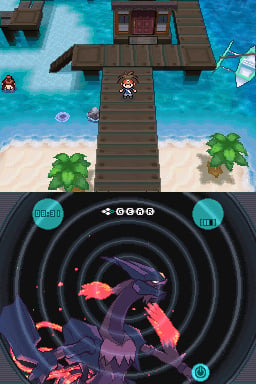
Pokémon Black 2 and White 2 were not enhanced versions like other games, but rather sequels to the story in Pokémon Black & White. Set 2 years after the events in Black & White, you play once again as new trainers going through the Unova region, who end up dealing with a reformed Team Plasma. In the end, you have to work with N and help stop Kyurem and fuse it with the dragon N had in the previous games.
This was a breath of fresh air to the expected third versions of the game, with a new story bringing in new possibilities. The game also increased the wild Pokémon in Unova, meaning you were no longer restricted to just the new Pokémon and could find more in each area. It also implemented a variety of new features including the Join Avenue, which brought in players you interacted with from around the world and allowed you to use them to set up shops for a variety of features. It also included the much beloved Pokémon World Tournament, where you could face up against every Gym Leader and Champion from all previous Pokémon games, as well as download new tournaments from the Internet. They were also unique in that they included unlockable Challenge and Easy Modes, which increased and decreased the levels of opponents respectively. Gym Leaders even had brand new teams in Challenge Mode.
That is it for the main series games in Generation V. With only four titles, it has the smallest amount since Generation II, but these were some of the more unique titles that Pokémon has had.
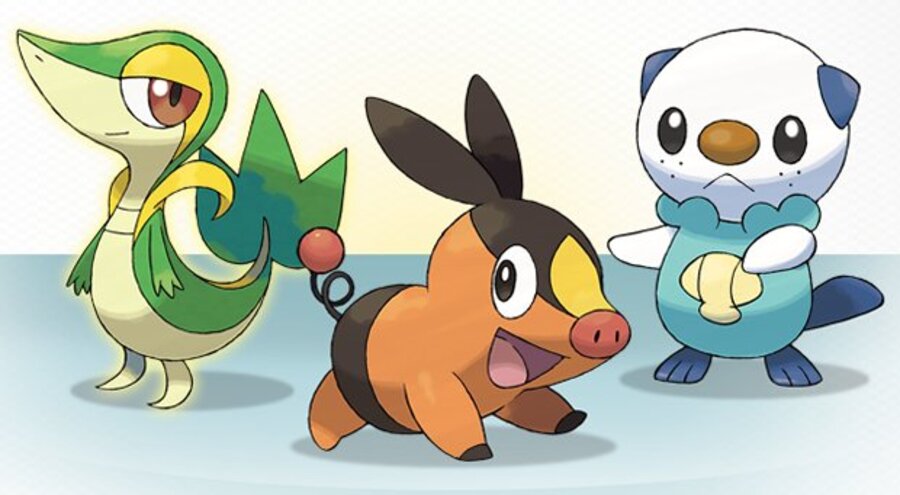
The Pokémon
As this generation started off with a soft reboot, all the Pokémon encountered in Black & White were new, totalling a massive 156 brand new Pokémon in the game, the highest introduced thus far, bringing the total up to 649. Unlike the previous generation, absolutely no Pokémon had any relation to any previous generation. To top that off, many of the Pokémon introduced became usable Pokémon of many obscure types such as Bug-type.
The starter Pokémon in this generation are the grass snake, Snivy, the fire pig, Tepig, and the sea otter, Oshawott, once again continuing the trend of Grass, Fire and Water-type starters. Unlike the previous generation, however, the final evolutions of these Pokémon go back to basics with Serperior being pure Grass-type and Samurott being pure Water-type. Tepig's evolution, Emboar, continues the tradition the past two generations set of Fire/Fighting-type final evolved starters.
Like the previous games, there was a very large amount of Legendary Pokémon in the game, nine in fact. The first three are a trio. The Steel/Fighting-type Cobalion, Rock/Fighting-type Terrakion and the Grass/Fighting-type Virizion. These Pokémon were commonly associated with being based on the classic story, The Three Musketeers by Alexandre Dumas. Next is another trio, commonly referred to as the Kami trio, the pure Flying-type Tornadus, the Electric/Flying-type Thundurus and the Ground/Flying-type Pokémon, Landorus. In Black 2 & White 2, these three Pokémon were given unique Therian Formes that allowed them to become more animal like. If you saw any VGC battles in 2015, chances are you saw at least one of these in each team. Finally, the three Pokémon that adorned the covers of the games, the Dragon/Fire-type Reshiram, the Dragon/Electric-type Zekrom and the Dragon/Ice-type Kyurem. Reshiram and Zekrom are often considered to be referencing the Tao, with Reshiram said to represent truth and Zekrom ideals. Kyurem also has the ability to fuse with Reshiram or Zekrom in order to become the far more powerful Black Kyurem or White Kyurem. It is said that the three Pokémon were once one Pokémon that split into Reshiram & Zekrom, with Kyurem being the leftovers.
There are four Mythical Pokémon in this generation too. The first is Victini, which is actually situated at the start of the generation's Pokémon list with the #000 Unova Pokédex number. It's Psychic/Fire-type and is said to represent and bring victory. Next is Keldeo, the Water/Fighting-type Pokémon. Keldeo is related to Cobalion, Terrakion and Virizion in a story that parallels d'Artagnan in that it was an orphan that is looked after by the three. It can change its form when it knows the move Secret Sword. Next up is Meloetta, the Normal/Psychic-type Pokémon that has the power to control people using the melodies it sings. Finally is Genesect, the Bug/Steel Pokémon. Genesect's backstory is different in that it is a Pokémon that lived in ancient times, but was restored and altered by Team Plasma. Its original state is not currently known.
For a full list of Pokémon, you can find them here: http://www.serebii.net/games/generation5.shtml
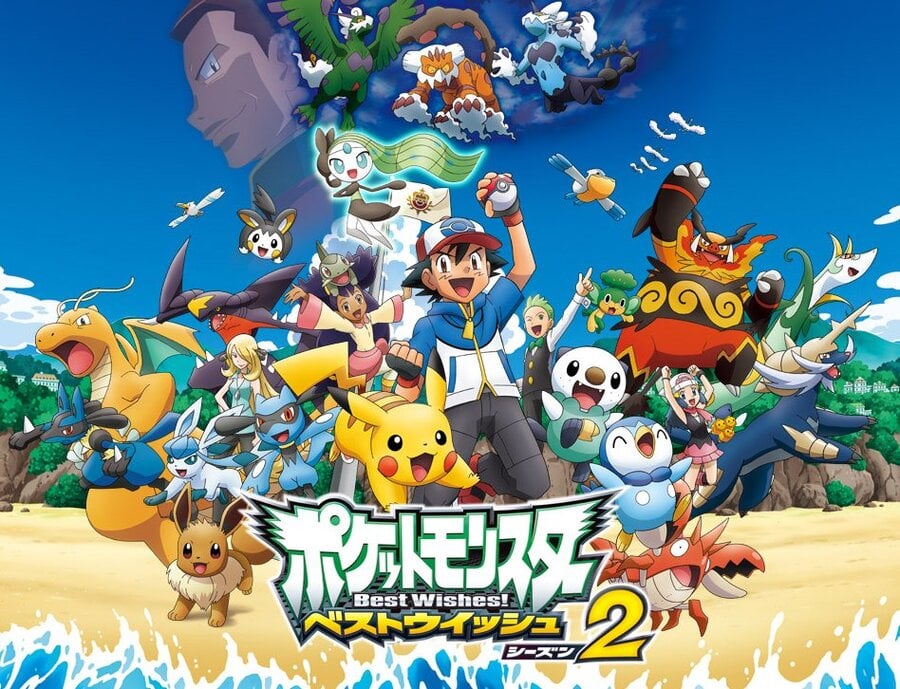
The anime
When September 2010 hit and Black & White came out, the anime shifted once again into a new generation. It changed its title to Pokémon Best Wishes in Japan, and like the games acted as a soft reboot for a while.
Ash and Pikachu set off on their own for the Unova region, but right after they land Pikachu was hit by the lightning strike of the legendary Pokémon, Zekrom, causing it to be severely weakened. Shortly after that, Ash met the mysterious Iris and her Pokémon Axew, his rival for the region, Trip, and soon afterwards the Striaton City Gym Leader, Cilan, who then joined him in the travels. Through the region, Ash went through battling the gyms once again to various levels of success, catching a variety of Pokémon including Pignite, Oshawott, Snivy, Unfezant, Boldore, Krookodile, Palpitoad and Leavanny. Team Rocket followed to Unova, being more serious at first following a special promotion by Giovanni.
In Japan, the anime went through a few transitions. To tie in with Pokémon Black 2 & White 2, the series became Pokémon Best Wishes Series 2, as Ash went to tackle the Unova League. During this, Dawn visited from Sinnoh for a while, and Meloetta joined Ash for a short time as Team Rocket went after Meloetta. This plot marked the first time Ash ever faced off against Giovanni, too. In the league, Ash lost in the quarter finals against a new trainer he met, Cameron, due to an unfortunately timed evolution of Cameron's Riolu.
Following the league, the show shifted again to Pokémon Best Wishes Series 2 Episode N. This subseries of the show featured Ash & co. still travelling through Unova where they met N and finally dealt with Team Plasma. Ash's Charizard returned during this series.
Finally, when Team Plasma were dealt with, the show shifted again to Pokémon Best Wishes Series 2 Decolore Adventures, which dealt with Ash, Iris and Cilan travelling through an island range on their way back from Unova into Kanto. This was a much muted series, dealing with just random happenings on the island, but did lead into the sixth generation with the introduction of the character, Alexa.
There were three sets of movies during the generation, each focusing on one of the Mythical Pokémon of the region.
The first movie was actually separated into two different ones: Pokémon the Movie Black: Victini & Reshiram and Pokémon the Movie White: Victini & Zekrom were a unique experiment where a similar story was told but with version exclusives, changing the starring and antagonistic Legendary Pokémon for the plot. In it, a man named Damon is intent on restoring a lost kingdom using one of the Legendary Pokémon and forcing Victini to help, leaving it up to Ash to solve it.
The second movie was a return to standard fare. This movie was called Kyurem and the Sword of Justice and featured Ash & Co. befriending the Mythical Pokémon, Keldeo, after learning of it and its associate Pokémon feuding with Kyurem. It's up to Ash to help Keldeo train and defeat Kyurem. This movie also featured a return of having a short attached to the movie. This short was called Meloetta's Moonlight Serenade and focused on the Mythical Pokémon, Meloetta.
The final movie is Genesect and the Legend Awakened. This movie featured a group of Genesect, led by a special Shiny Genesect start causing issues in a city that was built on what was their home thousands of years ago. Teaming up with a different Mewtwo to the one he remembers, it was left up to Ash and Mewtwo to solve it. This movie also introduced the concept of Mega Evolution, including Mega Mewtwo Y.
The Spin-offs
While Generation IV spin-off games largely stuck to what was tried and true, the fifth generation branched out with numerous brand new types of spin-offs, as well as a few familiar continuations.

Nintendo DS
The first spin-off in the fifth generation is a unique one, one which was only released in Japan and Europe. This game was called Learn with Pokémon: Typing Adventure. This game came bundled with a Bluetooth keyboard and had you capture Pokémon simply by typing them as you went through a stage. The faster you type, the more Pokémon you can get. It featured many boss Pokémon and has what many would argue is the greatest boss battle music of all time.
Pokémon Conquest was the last Nintendo DS spin-off title to be released. This game was a crossover between Pokémon and the Nobunaga's Ambition series by Koei Tecmo and was essentially a Strategy RPG. In it, you had to take over various kingdoms in Pokémon battles in an isometric battlefield. As you got more warriors on your side, you could do more including defend your kingdoms and continue on. The game had a large post-game where you could play as all of the various warlords.
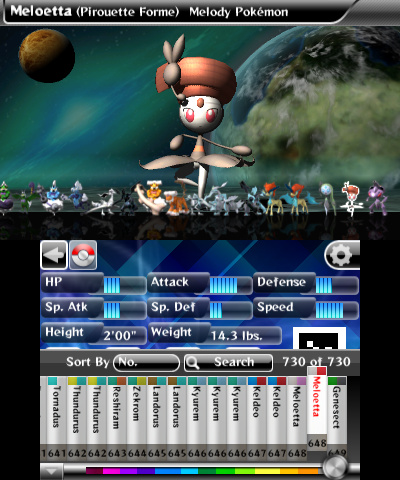
Nintendo 3DS
The first Nintendo 3DS title is not technically a game but rather a utility that came out in June 2011, when the Nintendo eShop went live. This was Pokédex 3D and provided all sorts of information on the 153 known Pokémon in the Unova Pokédex. It also contained a special AR viewer that let you take photos with your Pokémon using AR markers. It later had a paid sequel, Pokédex 3D Pro, which contained all 649 Pokémon and data from Pokémon Black 2 & White 2.
Next is the first true Nintendo 3DS title for Pokémon, Pokémon Rumble Blast / Super Pokémon Rumble. This was a sequel to the hit WiiWare title Pokémon Rumble and had you play as a Toy Pokémon who travelled through the world to find out why the fountains were drying up, causing Pokémon to rust. Unlike its predecessor it contained all 646 available Pokémon that were known at the time.
Next came Pokémon Dream Radar. This downloadable software was made to work in tandem with Pokémon Black 2 & White 2. In it, you helped Professor Burnett study the InterDream Zone where various Pokémon are said to be found. Using the Augmented Reality features of the Nintendo 3DS, you'd capture these Pokémon in the very room you're in and they could then be sent to you Black 2 & White 2 game. This was only way to get the Therian Formes of Tornadus, Thundurus and Landorus.
The final fifth generation Nintendo 3DS title was a continuation of the much beloved Pokémon Mystery Dungeon series, Pokémon Mystery Dungeon: Gates to Infinity. This game only contained 144 of the Pokémon, but had you play as a human turned into a Pokémon once again as they tried to solve the mystery of the Magnagates, portals that open up to various areas. This game utilised the 3DS's camera to scan any round object to create a special dungeon for you to explore. Ultimately, it is considered one of the weakest Pokémon Mystery Dungeon titles
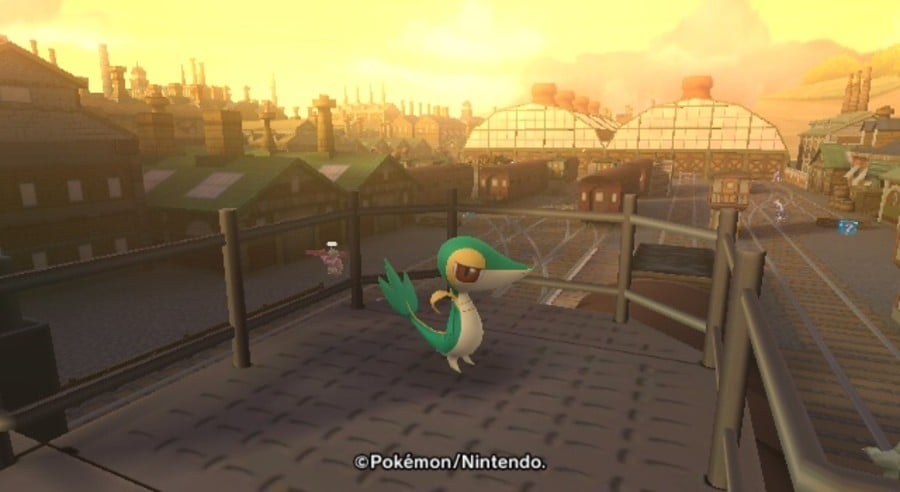
Nintendo Wii
Only one Nintendo Wii title was released in this generation. It is PokéPark 2: Wonders Beyond. This game was a sequel to the previous PokéPark game and had you play as Pikachu, Snivy, Tepig and Oshawott as they explored PokéPark and the nearby Wish Park in order to save the PokéPark. Unlike the predecessor, this game focused less on mini-games, but more on the Action/Adventure and exploration aspects introduced in the previous game.

Nintendo Wii U
Next is the first Nintendo Wii U title featuring Pokémon. This game is the third in the Pokémon Rumble series, Pokémon Rumble U. It featured you playing as Toy Pokémon again, this time as they work their way back to the Toy Shop after falling into a river. This game was scaled back in story and gameplay somewhat. Rather than exploring stages, you play in Battle Royale stages, achiving various accomplishments and beating boss Pokémon to move on. This game was also the first Nintendo Wii U title to utilise NFC technology. In tandem with the game's release, 21 special NFC figures were released. These could be scanned into the game and customised in level, strength and moves, with the data then saved onto the figure and able to be used at any time.
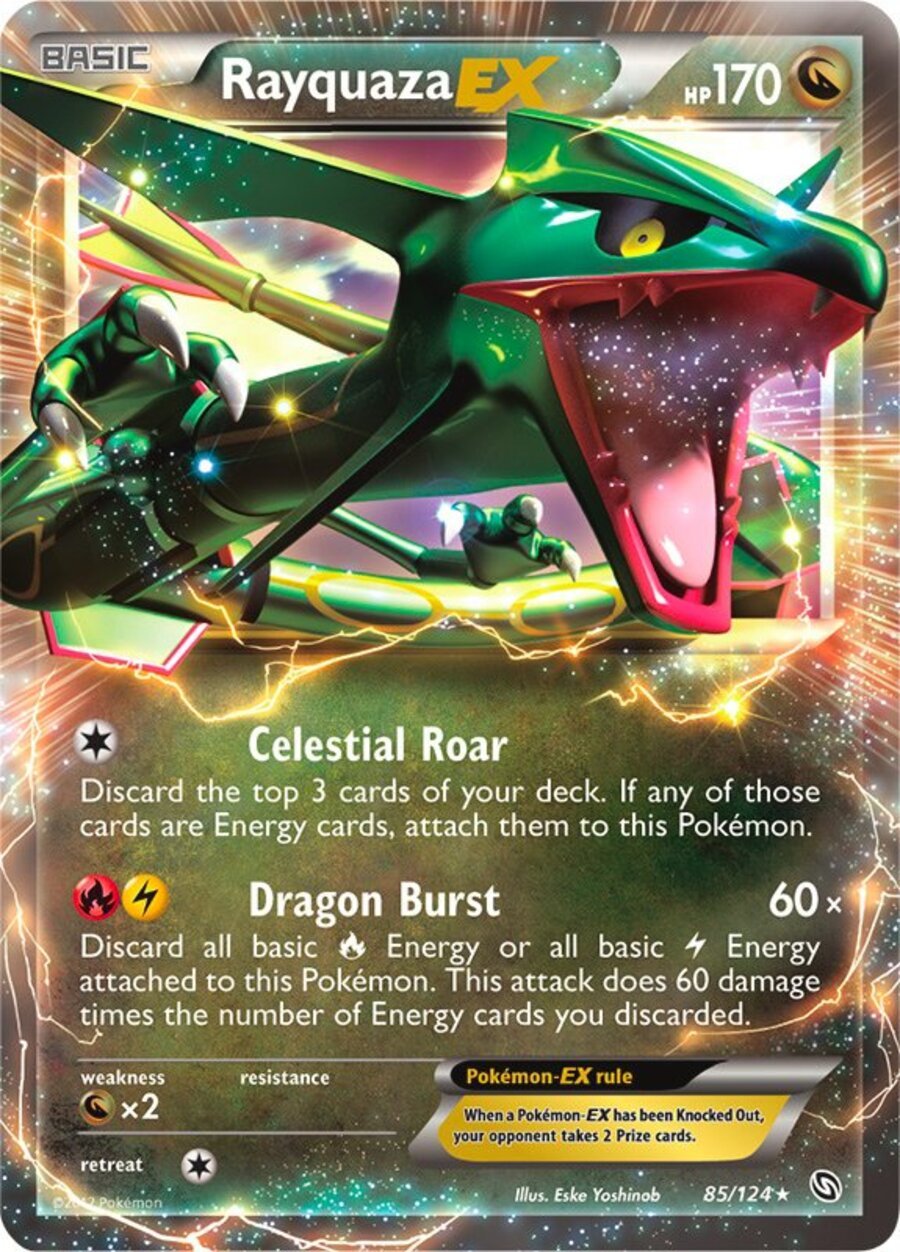
The TCG
The Trading Card Game continued on through Generation 5 with a variety of new cards. These cards continued with some of the mechanics from Generation 4, but also most notably reintroduced a classic.
In the third generation, many Pokémon cards were released called Pokémon-ex. These cards were powerful Basic Pokémon and, if defeated, allowed for 2 Prize Cards to be taken. These were reintroduced in the fifth generation, this time in upper-case as Pokémon-EX, and is a mechanic that continues to this day.
The most notable change for the TCG in this generation though is the introduction of a brand new type. The first new type since the introduction of Metal and Darkness in 1999. This is the Dragon-type for all the Dragon-type Pokémon in the game. Unlike the other types, there's no Dragon-type energy, but rather the Dragon-type Pokémon use a combination of types in order to get their move.
Conclusion
As we approach October 2013 in our retrospective, the fifth generation of Pokémon comes to an end. This generation is one that many consider a stop-gap between the DS and 3DS generations, considering the length of the generation and the fact not much new was brought in, but when you look at the Internet features introduced, this generation definitely brought a lot into it.
While it only lasted 3 years in Japan and 2 and a half years in the West, it is definitely a generation that will be remembered.





Comments 50
These articles just keep getting me hyped for that potential Pokemon 7th gen announcement. I know it seems early, and we still haven't gotten that third title in the X and Y series, but I'm just craving another Pokemon game.
Who thinks they will have a new 3ds exclusive pokemon game for gen 7.Using amiibo and more power processor.
And it will help sell the new 3ds along with new 3ds only downloadable DS games of heartgold and solesiver.
I wasn't so keen on this generation as previous generations. The pokemon designs were much more complex in Black and White, which made them less like animals that could be found in the real world, and more like generic video game creatures. Plus, this generation had some silly designs, like a garbage bag or an ice cream. Granted there were were other silly pokemon in previous generations like magnets and hearts, but Garbador and Vaniluxe stood out more since their concepts were so ridiculous. There's still plenty of great new pokemon though, like the monkeys, and Zorua/Zoroark.
The thing I disliked most with these games were the lack of exploration. If you look at the map in Black/White and removed the right half of the circle since that was mostly post game, then it was a line. Most of the routes and caves also felt fairly linear. Black 2 and White 2 improved though, and had some decent exploration such as in Victory Road.
There's some great things in generation 5. The story in Black/White was the best out of any main pokemon game. N, Ghetsis an Colress are some of my favourite characters in pokemon games. I also spent a lot of time in the Pokestar Studios and the PWT in Pokemon Black 2, though I missed not having contests and the Battle Frontier.
Despite my negativity here, I still enjoyed generation 5, just like how I enjoy all pokemon games. I just feel that it also let me down in places and didn't meet my high expectations.
"The build-up to launch"? What build-up? Generation V came out of nowhere, and maybe too soon considering people were just re-discovering the wonders of Johto... but then again, it's the same ol' bias you'd expect from me.
However, for being "Generation III on steroids", what with the previous generations' Pokémon not appearing at all before the postgame, Gen V did things surprisingly well. Black and White had an amazing story, and while perhaps their direct sequels weren't "as epic", they made up for that by being the very essence of fanservice (the non-sexual kind thereof) in gameplay terms, with the astonishingly rich Regional Dex, the amazing variety of battles, Pokéwood, and maybe the most amazing cavalcade of older human characters, known as the Pokémon World Tournament. Game Freak needs to make that a series staple ASAP.
I never did get around to playing the sequels. I don't hate gen V, but very few of the pokémon designs appeal to me. I'll have to pick up a copy of Black 2 or White 2.
Pokemon Black and White are actually my favorite Pokemon games.
The writing was surprisingly good, I did like most of the Pokemon Designs, and while I admit the graphics were a bit pixilated I still really like the presentation and tone they were going for. Overall, almost everything about these games impressed me much more than X and Y.
@AlexSora89
I really loved Pokemon World Tournament. I'll admit that I was disappointed of a proper battle frontier like Platinum, HG, and SS. But having a tournament focused on a smarter AI encouraging competitive battling against every gym leader and champion in the past was complete genius and made up for it.
Generation five was my favorite generation game wise. I absolutely loved bw, b2w2, and conquest. Many of my favorite Pokemon designs also came here. Yes people like to harp on this generation for garabador and vaniluxe but those were few out of great designs like leavanny, hydreigon, bisharp, haxorus, etc.
Anime though... I don't like to talk about that... Cough Cilan and his freaking food puns Cough.
Most of the Gen 5 Pokemon are very loosely based on Pokemon from previous generations.
I know, @Seacliff. At first I was like, "where's mah Battle Frontier?", then I was like, "screw the Battle Frontier, I can fight Red and all the other champions at will and this is enough for me"!
Gen V is probably my favorite. It did take me back to the original. And with the climax happening at the elite 4, I'd have to say the story is one of the best in the series.
Gen V is probably my favourite for Pokemon designs after gen III. There's still loads of interesting Pokemon from that gen I'd like to use that I haven't gotten around to yet.
The weakest Pokemon Mystery Dungeon games ,from what I heard,were the Wii Ware ones released only in Japan.Also in my opinion,the first series rescue was not that good.
About the main series this is probably ma favorite gen since crystal days.
The only good thing about Gen 5 was Trubbish and Garbodor... Okay Chandelure is awesome too, and some others have grown on me, but I really didn't enjoy this game like I did Gen 4 before it and Gen 6 after.
Where the series went wrong IMO. The series didn't need the reboot 5th gen brought us and they started bending over backwards for casuals in this generation with linear region design and decreased difficulty. There was certainly some good things about the generation like the story and having sequels instead of remakes, but for the most part it was a step backwards for the series.
Easily my favourite gen. The story was amazing, especially with the sequel. I actually miss it quite a lot as Team Plasma actually felt like a real threat.
Compare that to X and Y where it was already obvious who the villain was the first time you meet Lysandre barely 4-5 hours into the game :C
Also I personally feel it was a huge step up from gen 4 which I found really boring and not a lot of it really stuck with me. The underground stuff was nice though I would have enjoyed that coming back in gen 5.
Probably my least favorite gen. The designs weren't as bad as people made them out to be, however I think they just tried to hard to make them similar to Gen 1 Pokes.
And for the record, I actually like the Vanillite family a lot, I don't what people's problems with an ice cream Pokemon are. I think the real worst offenders from the gen are the monkeys, who were only created for the triple battle gimmick, Gothitelle, Terrakion, Cobalion, the kami trio, Samurott, Accelgor, etc... Just a lot of garbled, bland designs imo. It does have my favorites though, like Braviary, Joltik, Zekrom, Chandelier, etc.
Designs aren't my biggest complaint though, as just looking back on this gen I can't remember having a lot of fun with it or anything that I really enjoyed. It was an exciting game at the time, we had new animations and triple/rotation battles, but something about B/W just felt bland, almost as if it didn't live up to the expectations for me personally.
However, I still haven't played B2/W2!
Generation 5 was a risky gambit that ultimately paid off with the release of Black and White. Sure Ruby and Sapphire forced you to use a lot of the new Pokemon (unless you were fine with a Zubat or Geodude early on), but with Black and White you could not get any other Gen 1-4 Pokemon until you defeat the champion. I enjoyed my playthrough of Black since it forced the players to adapt to a new region while offering a compelling story that offers a lot of character development and insights to a topic that almost everyone ignored. I think N may potentially represent Pokemon's greatest character since he's a friend, rival, villain and champion all in one package. Heck, he's one of the few trainers to actually capture and use a legendary Pokemon to battle your team. Although Black 2 and White 2 did miss the opportunity to tell a compelling story, the enhanced difficulty and challenge mode makes the main story rather challenging and the being able to battle ALL the champions of all 5 generations made up for the absent of the Battle Frontier.
BW 2 are some of my favorite games ever.
You left out arguably the most notable mechanical change: reusable TMs! It was a very welcome move, as with the ever expanding Pokédex it no longer made sense to be so restrictive with the extra teachable attacks (aside from a few move tutors), and it wouldn't have been feasible to just keep increasing the number of TMs like they did in Generation 4. It's then pretty well balanced by the fact that they don't hand out most of the really good TMs until late in the game. I just wish they wouldn't make us wait to buy some of them with large amounts of Battle Points.
Anyway, the "soft reset" thing was a pretty good experiment, but I think it would be best if it remained a one time thing. We did get a huge amount of new Pokémon out of it, most of them with excellent designs (although there will always be a few clunkers like Trubbish/Garbodor in this case; EDIT: Hey, I like Vanilluxe!), and the lack of new evolutions was refreshing after Gen 4 really went overboard in that regard.
Technically, Ash did face off against Giovanni in "Mewtwo Returns," although you're correct that the Meloetta Arc was the first time they ever directly interacted with each other.
Speaking of which, no meantion of Meloetta's Pirouette Form? Also, isn't "Kami" the Japanese word for the Shinto Gods? I always thought Tornadus, Thunderus, and Landorus were the Elemental Genies (or Djinni if you prefer the classical spelling).
@FriedSquid I'm pretty sure the monkeys were made as a way to work around the whole "have to grind to beat the 1st gym if you pick the 'wrong' (as in weak to the leaders type) starter" situation that was in the 1st go of gen 1-4 since they did it so you fight the 1st gym leader who's monkey beats your starter, but can get the monkey that beats their's before the gym to effectively put all 3 starters on equal ground for the 1st gym, which was my personal favorite quirk/gimmick of gen 5.
@ASonic3582 Well if that's the case I personally think that's a lame reason to make them. That to me just seems too easy, to give you an advantage no matter your starter. And in any case, that's a problem with most generations — they really should have the first Gym be a type that has no strengths or weaknesses to any of the starters in the first place.
Plus, those monkeys just look boring to me... I don't think I would mind so much if they made each one more different than the other, or maybe even made them different animals. I mean, imagine if every Gen 1 starter looked just like Charizard, only one was blue and another was green. I don't mind the trash or Ice cream mons, I think a lot of Gen 5 Pokemon just had lazy designs.
Sorry, rant over.
@FriedSquid Well, that wouldn't leave them with many options. The only types that are completely neutral to all three of them are Fighting, Psychic, Ghost, Dark, and Dragon (well, not neutral but equally fair in the latter's case); and I can't see them using Ghost or Dragon for the first gym.
All the love for Meloetta! XD}
jiji, well, Really I like this generation: full animated sprites; low HP and last Pokemon Music Battle; unique Gyms Music (B2 & W2); An Interesting Story and Great Characters; Beautiful Scenaries; Official Online Tournaments/Events and again, Meloetta, XD
Loved this gen, but the anime sucked balls.
As I mentioned in the 4th Generation retrospective, this right here, despite what everyone is saying, is my favorite generation. I witnessed as the first new Pokémon were announced. I love all the Pokémon here. Heck, I even watched the anime for a few episodes, found both Iris and Cilan to be extremely annoying in their own right and stopped watching that. I also love that we do have Black 2 and White 2 to show what actually happened after the first two games.
Also there's my absolute favorite Pokémon Cofagrigus. Sure, I don't know how to get him to work in a competitive battle but just look at him. He can crawl on walls and ceilings for crying outloud.
And the story was actually moving in the first two games, too. Yeah, I'm amazed at that, too. It's not Undertale or anything but you just gotta feel sorry for N.
Generation 5 has to be one of my favorite generations ever. Pokemon Black and White was an amazing return to Pokemon's glory GBA days and was a complete breath of fresh air after the crap that was Generation 4. The Pokemon designs were unique a lively, the region was full of life, the characters were likable, the plot was good, the game is full of content, it had some cool spin-offs, ect. Generation 5 was just a freaking master piece of a Generation and will forever be my favorite pokemon generation. Too bad that Generation 6 sucks so hard that it's near Generation 1 levels of bad.
I missed the start of this gen due to illness so White 2 was my first game only a few weeks before X&Y. Looking forward to the remakes in a few years time, wonder what system we'll be playing em on!
Black/White is my favourite Pokémon game. I had taken a long break from the series at that point, but so much about this was new and it completely hooked me. Not just the pokémon or the surprising focus on story, but lots of little tweaks and enhancements. I also loved Unova and thought the presentation was lovely, with improved graphics and wonderful music.
The story isn't just "good for a Pokémon game" it's legitimately good, which surprised and delighted me. It was a shame that after this game story again became an afterthought, and the less said about Black/White 2's Purrloin the better.
Many have bemoaned the pokémon designs - some were bland, which I always find to be the case, though I liked most of them - but there were some wonderful new type combinations. The bug/fire Pokémon volcarona and dark/dragon hydreigon quickly became firm favourites for me.
Pokémon White is the game that reignited my love for the series.
Gen 5 is best gen.
Black & White are the best in the series, imo. For their time, Red & Blue were equally great, but in direct comparison to Black & White their gameplay exhibits a fair number of flaws, though the overall concept, plot and feel remain just as great.
Pokemon Dream Radar and Black 2.......
They have forced me to use about 150 ppup's and about the same amount rare cadies immediately because nintendon't (no sending to X/Y)
Dream Radar only for Therian formes.......wait? You can get them easily in Omega Ruby/Alpha Sapphire...
Pokedex 3d Pro? Joke. You get better informations for free.
Gen 5 is like marmite. Love it or hate it, you can't live without it. Why? Because Landorus-Therian, that's why.
My least favorite generation by far. I don't like the vast majority of the Pokemon designs, and the Pokemon themselves were largely pointless additions to the series that serve no other purpose than being 5th gen counterparts to gen 1 Pokemon (because this was supposed to feel like a reboot as the article mentioned). The region was way more linear than any other Pokemon game, with the design of the world basically being a circular path, whith each new city you visit containing the next gym.
I also felt that the game tried to simulate 3D objects too much, and the graphics suffered immensely because of it. The sprites in this game were all poorly done. Pokemon moving sprites looked atrocious as the were very pixelated and stretched, rather than animated, which looked even worse as they slowed down due to losing HP in battle. In the overworld, character sprites were also very pixelated and faces were always scrunched up and distorted unless you were within one square of the character.
TLDR; Gen 5 is/was bad for a large portion of the fanbase and Game Freak knew it, which is why it was quickly swept under the rug. Only 2 core games and a 2 year run speaks for itself.
I am going to say it, Gen 5 was the worst one.
This generation introduced Meloetta, so that automatically makes it the best.
Gen V gave us Haxorus and Oshawott. It's definitely not the worst on that alone. Also reusable TMs!
Just like original R/B/Y Nintendo (or The Pokemon Co/ whoever oversees it) should release al the other gens on the 3DS or the next handheld. Even if they can't trade (with ORAS/XY out it doesn't really matter) I would love to have them all legally because I hate playing them on a pc or laptop.
@FriedSquid @BulbasaurusRex They actually took that neutrality thing in the way you 2 explained in B2/W2. Since gym 1 is normal and neutral to all 3 in those, though Riolu was avalible beforehand and if one really wanted to grind Tepig they could.
The best of all "modern" (starting from GBA) generations. The fresh air the series desperately needed. The generation that brought hope for the pokemon franchise. It is too bad that when they (GF) finaly got the courage to begin experimenting with the formula, the backslash from the fan made them return to their safe route. Now they are more focused at adding gimmicks to keep fans attention without letting any of the fresh air to the series.
Victini, Krookodile, Zoroark, Chandelure, Haxorus, Golurk, Braviary, Hydreigon, Volcarona, Zekrom, Kyurem, Keldeo and Genesect were all my favourites from Gen V
Just read throug all the articles. Really hyped for the 20th anniversary now.
Pokemon, a a great history, and hopefully great things to come.
SoulSilver was my first Pokémon game, but White just blew me away. White 2 was absolutely amazing, and holds the record for my number 1 favourite Pokémon game ever. I love the post-game, I love the story, I love the region, I love the new features, and I love the Pokémon. Easily my favourite gen!
I wish they´d do the same thing with Gen 7, having old Pokémon appear in the postgame. That's one of my favourite things while playing a new Pokémon game: discovering all the new creatures and forming the team consisting of only new Pokémon.
I was a little dissapointed with Black and White. While I enjoyed it and played it just as much as the previous titles, I didn't feel like it improved as much upon the ever-deepening Pokémon experience. The Rotation and Triple Battles were too rare to have any major effect on the game and only really shone in multiplayer. I missed many features like a Battle Frontier or a Safari Zone, and while there was a massive helping of 150+ new creatures to collect, their designs were kinda hit and miss. For every badass Seismitoad or Darmanitan there is a Klink (literally two spinning gears) or Woobat (just a Psychic-type Zubat). The graphics weren't really an improvement either, even with the battles finally being animated.
There was a lot of cool stuff, too. I did like how you don't see any Magikarps, Pikachus or Zubats, but instead find only new Pokémon you never met before (even if some are like rehashes). No forced evolutions or lower forms of old Pokémon like in Generation four, just new faces. And, while familiar, the plot has more meat because the main heroes and villians are more fleshed out, making you actually care about them. Oh, and the fact you can now use TM's over and over like HM's is a blessing and a subtle but distinctly useful improvement for competitive players. Speaking of multiplayer, the C-Gear finally made the on-the-go, social experience come full circle (and a long way since the link cables of late 90s and early 00s schoolyards). One small thing I personally really enjoyed was the first gym. At first you are tricked into believing this is a Normal-type gym full of generic creatures. But once you reach the Gym Leader, your opponent is actually decided by what Pokémon you pick at the start. It's always the one strong against your starter, so if you pick Oshawott the Water-type, you face a Grass specialist, the firey Tepig makes you face a Water-type trainer and Grass creature Snivy nets you a Fire-type master to fight. The fact that there is a replacement Pokémon available in the area - so as to mess with the Gym Leader's strategy - is a perfect example of Pokémon's depth and fun factor.
Then came Black and White 2. I was surprised they didn't opt for the mandatory third version, but went the extra mile and made a sequel instead. And what a genius move it was. The old cast from the first game was two years older. They are wiser, more mature and all the more enjoyable if you played the first game. There are many more Pokémon available right away. While it takes away the freshness of the first game, adding Pokémon from old generations is more befitting for a sequel and gave much more room for team building and experimenting with different creatures. It ultimately felt more like the game I didn't get with the first two games.
In the end, I still think they should have taken the time to make Black and White a 3DS title. What we got felt a little like a filler generation (even with the sequel being better). The rough start of Nintendo's new handheld could have been prevented if Pokémon had been a launch title.
I love the trading card games. I just got Pokemon Trading Card 2 GBC on an english fan translation cartridge! Been loving it, so much better than the 1st one.
The best story this generation has
Tap here to load 50 comments
Leave A Comment
Hold on there, you need to login to post a comment...